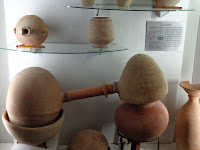On a day-to-day basis, I don't feel unsafe in Islamabad, but since we've been in Pakistan, a few events -- about which many wonderful concerned friends have often messaged us on Facebook -- have prevented us from getting too comfortable. (Seriously, if you Google pakistan and "on high alert," you get more than 5 million hits.)
All of these incidents remind us to not get complacent about our security. But it doesn't mean we continually barricade ourselves in our houses either. When situations are relatively stable, we manage to explore our temporary home -- following all procedures and taking all precautions, of course.
A while back, we escaped the city with a group hike in Bhurban. We almost got lost by following a winding road too far into the valley (top left), but eventually, we got back on track, literally, and found a great vista of the Margalla Hills (top right). After a couple of hours walking among the crisp air and evergreens, we settled down for lunch at the Pearl-Continental Hotel, which also offers a wonderful view of the surrounding hills (bottom).
The hotel mainly serves those with Western sensibilities, so I had reasonably authentic tostadas for lunch. That very same night, for dinner, we sought a more Pakistani spread at Pindi Food Street, a row of restaurants that fill to capacity most nights (top). Among the many establishments, we choose Shahenshah Tikka House, which has a huge outdoor patio and BBQ pit (bottom left). Among the shared dishes of our economical, self-selected sampler platter were chicken kebabs and mutton karahi (bottom right).
Another weekend, we decided to be tourists at Taxila, a UNESCO World Heritage Site. Our group (safety in numbers, always!) began its tour at the site's museum (left), where a guide gave us information about some of the artifacts on display that were excavated nearby. I particularly liked the centuries-old distiller (right), which functions in much the same way as the distiller in our house, except that the water was heated by fire whereas ours is heated by electricity. (It's also possible that the ancient system distilled something other than water, but the posted description didn't mention that.)
Taxila encompasses a nearby area of many square miles, so you have to drive from site to site. Our first stop was Sirkap (top left), a city where three levels of civilizations -- Greeks, Indo-Scythians and Indo-Parthians, then Kushans -- have been identified in the ruins (top right). However, these civilizations were not completely distinct, and there is evidence that they overlapped and merged over time, as shown in the different carvings at the "double-headed eagle stupa." The one on the left shows the architecture and an animal, an eagle, of the native Indo-Scythians, but the one on the right has a non-indigenous tortoise atop a more Asian-style gateway, probably based on the traditions of the Kushans (bottom).
At Mohra Moradu, the Buddhist beliefs held by many in the civilizations is clearly displayed. There are many well-preserved Buddhas, albeit headless, including "healthy Buddha," whose belly button you are supposed to rub for physical well-being (top left). Mohra Moradu is also where one of the most elaborate stupas, or monuments containing the ashes of monks, was uncovered (top right). It was found off a courtyard surrounded by numerous meditation cells (bottom).
Our guide led us up the hill above Mohra Moradu to an interesting cave. None of us dared to go too deep into the abyss, as we certainly did not believe that the chirping we heard was from birds, not bats, as the guide proclaimed (left). But the hike up provided a lovely spot to view the green expanse of the Taxila region (right); it is no wonder that so many people decided to settle in this fertile area, even before it became a stop along the Grand Trunk Road.
At Mohra Moradu, a prominent tree has been converted to a shrine to Sufis, who are credited with helping convert the Buddhists in Pakistan to Muslims. At Pipplan, the transition from Buddhism to Islam -- yet another evolution of the Taxila region -- could be seen in the form of a Muslim cemetery that had been created right beyond the walls of the Buddhist temple.
The last stop of our tour was the piece de resistance: Jaulian. This Buddhist temple is a more embellished and unspoiled version of Mohra Moradu. Beside the courtyard of meditation cells lies one main stupa surrounded by numerous smaller ones (left). And because Jaulian is in a gorge protected from eroding winds, the carvings on the stupas are more distinct (right).
Throughout the day in Taxila, the contrast of present-day Pakistan to the one of the past, where groups with different beliefs converged to form a long-standing civilization, was not lost on me. Nonetheless, it was nice to be reminded of the peace that can be found in this country -- whether it be in the serenity of a verdant hillside, the amiability of a dinner table, or the community of a cultural outing.



















No comments:
Post a Comment